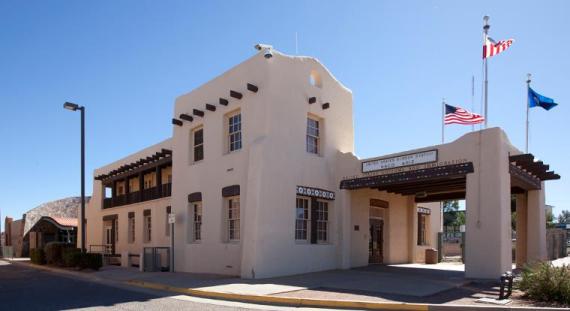GSA Helps Preserve Historic “one of a kind” Border Station in Arizona
By Javier Fernandez

There’s something unique about the old border station on South Towner Avenue that seems to capture the attention of even the most casual observers. A textbook example of Pueblo Revival architecture, the Naco Land Port of Entry (LPOE) in Arizona stands out in sharp contrast to the nearby red brick masonry buildings. Its adobe-like batter surfaced walls, flat roofs, rounded edges, terraces, and projecting roof beams are all architectural details that celebrate American Southwestern Architecture. The building also has the distinction of being the only port of entry ever built in the popular Pueblo Revival style.
Today, the Naco LPOE looks very much as it did when it was built by the U.S. Treasury in 1936. This is largely thanks to a small group of dedicated professionals tasked with protecting an important part of the nation’s architectural heritage. As a responsible steward of historic buildings, the U.S. General Services Administration (GSA) manages a program dedicated to preserving historic federal buildings. The agency’s impressive portfolio of 425 historic buildings constitute a diverse collection of irreplaceable pieces of architectural history that connect us to our past.

The Naco LPOE has undergone a series of historic preservation projects that spans more than a decade. And as the port nears its construction centennial in 2036, the aging facility finds itself increasingly in need of building systems repairs, maintenance, and structural stabilization projects. Leading these efforts have been Historic Preservation Officer and Specialist Jane Lehman and Natalie Loukianoff from GSA’s Pacific Rim Region’s Design and Construction Division. They have overseen numerous historic preservation projects at the port, including an exterior stabilization project that repaired doors and windows, as well as repaired and painted stucco surfaces.
“There are unexpected levels of complexity to our work that are not always immediately evident,” noted Jane Lehman, who’s been in her current position for the past 17 years. “Materials are a surprisingly stubborn challenge. We try to use the most historically accurate materials for decorative wood and stucco accents. At the same time we’re also dealing with a harsh desert environment and all of the preservation challenges that come along with it.”
Attention to detail – For the 2021 exterior stabilization project, a historic preservation sub-consultant was contracted to map every crack on the stucco longer than one sixteenth of an inch and identify the appropriate repair for each.
More recently, a $270,000 BA-64 funded project improved the building’s overall functionality and increased its usable square footage. Budget Activity (BA) Code 64, also known as Historic Program Funds, uses rental income generated from historic outleases to preserve historic GSA buildings. The project involved transforming an existing window into a secondary exit that connects to a set of stairs. The project preserved the port’s historical elements and respected its architectural character while functionally upgrading the facility. This allowed the U.S. Customs and Border Protection (CBP) to have more space, gaining a large conference meeting room and additional office space.

 U.S. General Services Administration
U.S. General Services Administration